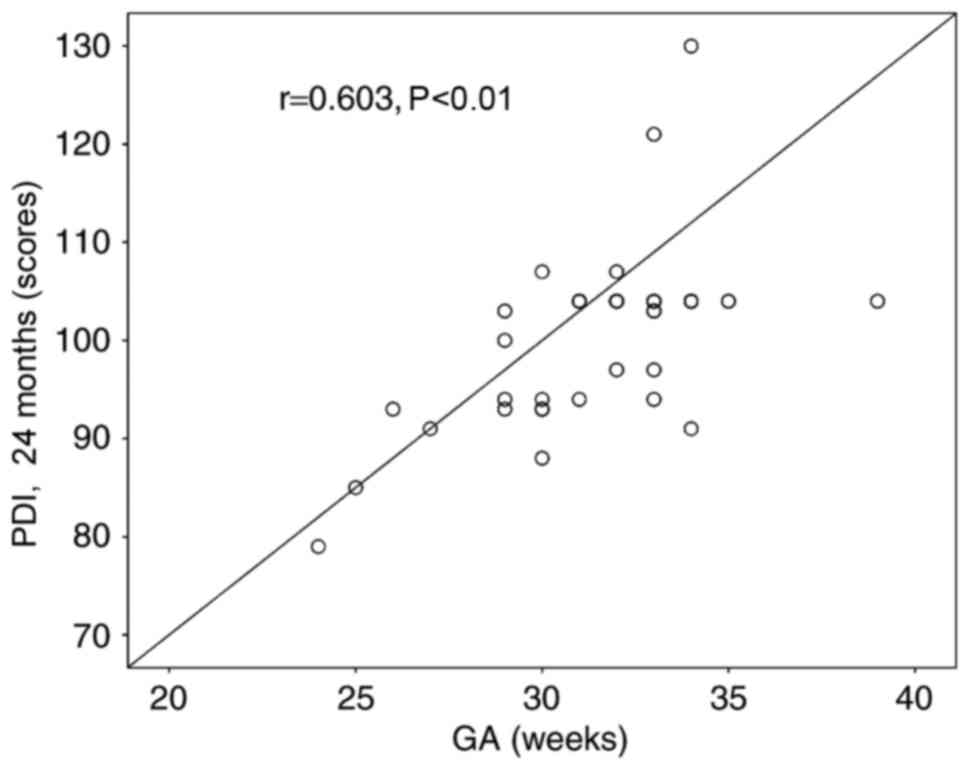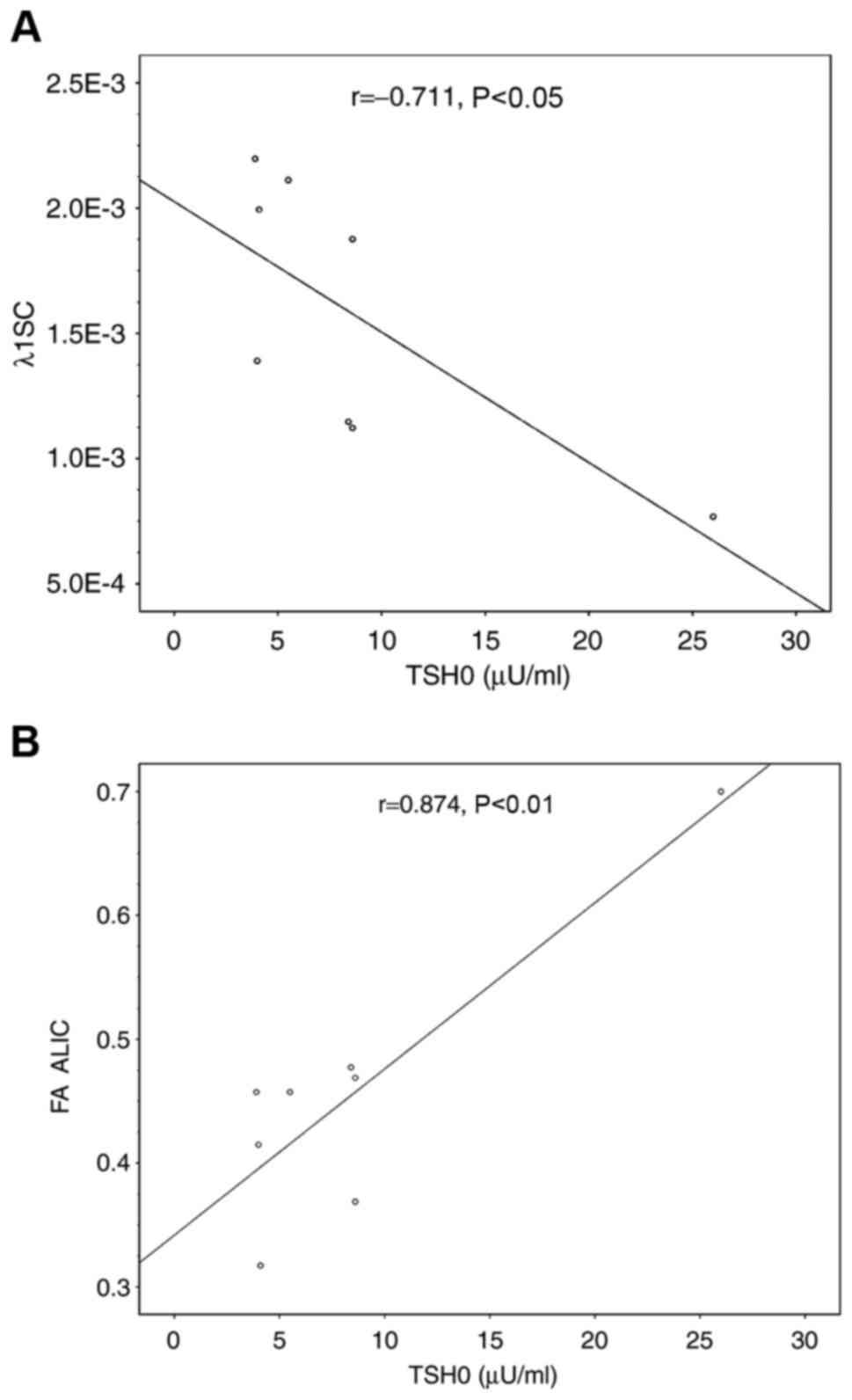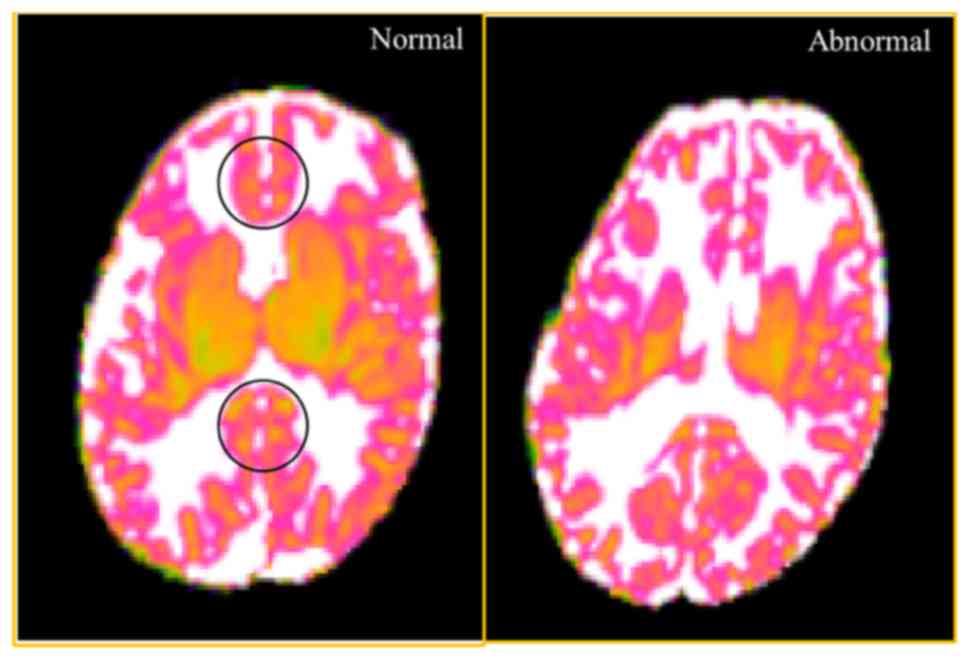|
1
|
Patel J, Landers K, Li H, Mortimer RH and
Richard K: Thyroid hormones and fetal neurological development. J
Endocrinol. 209:1–8. 2011. View Article : Google Scholar : PubMed/NCBI
|
|
2
|
Meijer WJ, Verloove-Vanhorick SP, Brand R
and van den Brande JL: Transient hypothyroxinaemia associated with
developmental delay in very preterm infants. Arch Dis Child.
67:944–947. 1992. View Article : Google Scholar : PubMed/NCBI
|
|
3
|
Ahmed OM, El-Gareib AW, El-Bakry AM, Abd
El-Tawab SM and Ahmed RG: Thyroid hormones states and brain
development interactions. Int J Dev Neurosci. 26:147–209. 2008.
View Article : Google Scholar : PubMed/NCBI
|
|
4
|
Ahmed RG: Hypothyroidism and brain
developmental players. Thyroid Res. 8:22015. View Article : Google Scholar : PubMed/NCBI
|
|
5
|
Den Ouden AL, Kok JH, Verkerk PH, Brand R
and Verloove-Vanhorick SP: The relation between neonatal thyroxine
levels and neurodevelopmental outcome at age 5 and 9 years in a
national cohort of very preterm and/or very low birth weight
infants. Pediatr Res. 39:142–145. 1996. View Article : Google Scholar : PubMed/NCBI
|
|
6
|
Vigone MC, Caiulo S, Di Frenna M,
Ghirardello S, Corbetta C, Mosca F and Weber G: Evolution of
thyroid function in preterm infants detected by screening for
congenital hypothyroidism. J Pediatr. 164:1296–1302. 2014.
View Article : Google Scholar : PubMed/NCBI
|
|
7
|
van Wassenaer AG and Kok JH:
Hypothyroxinaemia and thyroid function after preterm birth. Semin
Neonatol. 9:3–11. 2004. View Article : Google Scholar : PubMed/NCBI
|
|
8
|
Schoonover CM, Seibel MM, Jolson DM, Stack
MJ, Rahman RJ, Jones SA, Mariash CN and Anderson GW: Thyroid
hormone regulates oligodendrocyte accumulation in developing rat
brain white matter tracts. Endocrinology. 145:5013–5020. 2004.
View Article : Google Scholar : PubMed/NCBI
|
|
9
|
Sugisaki T, Noguchi T and Tsukada Y:
Cerebral myelinogenesis in the Snell dwarf mouse: Stimulatory
effects of GH and T4 restricted to the first 20 days of postnatal
life. Neurochem Res. 10:767–778. 1985. View Article : Google Scholar : PubMed/NCBI
|
|
10
|
Korzeniewski SJ, Birbeck G, DeLano MC,
Potchen MJ and Paneth N: A systematic review of neuroimaging for
cerebral palsy. J Child Neurol. 23:216–227. 2008. View Article : Google Scholar : PubMed/NCBI
|
|
11
|
Gupta RK, Bhatia V, Poptani H and Gujral
RB: Brain metabolite changes on in vivo proton magnetic resonance
spectroscopy in children with congenital hypothyroidism. J Pediatr.
126:389–392. 1995. View Article : Google Scholar : PubMed/NCBI
|
|
12
|
Jagannathan NR, Tandon N, Raghunathan P
and Kochupillai N: Reversal of abnormalities of myelination by
thyroxine therapy in congenital hypothyroidism: Localized in vivo
proton magnetic resonance spectroscopy (MRS) study. Brain Res Dev
Brain Res. 109:179–186. 1998. View Article : Google Scholar : PubMed/NCBI
|
|
13
|
Berman JI, Mukherjee P, Partridge SC,
Miller SP, Ferriero DM, Barkovich AJ, Vigneron DB and Henry RG:
Quantitative diffusion tensor MRI fiber tractography of
sensorimotor white matter development in premature infants.
Neuroimage. 27:862–871. 2005. View Article : Google Scholar : PubMed/NCBI
|
|
14
|
Basser PJ and Pierpaoli C: Microstructural
and physiological features of tissues elucidated by
quantitative-diffusion-tensor MRI. J Magn Reson B. 111:209–219.
1996. View Article : Google Scholar : PubMed/NCBI
|
|
15
|
Song SK, Sun SW, Ramsbottom MJ, Chang C,
Russell J and Cross AH: Dysmyelination revealed through MRI as
increased radial (but unchanged axial) diffusion of water.
Neuroimage. 17:1429–1436. 2002. View Article : Google Scholar : PubMed/NCBI
|
|
16
|
Pereira DN and Procianoy RS: Effect of
perinatal asphyxia on thyroid-stimulating hormone and thyroid
hormone levels. Acta Paediatr. 92:339–345. 2003. View Article : Google Scholar : PubMed/NCBI
|
|
17
|
D'Agostino JA: An evidentiary review
regarding the use of chronological and adjusted age in the
assessment of preterm infants. J Spec Pediatr Nurs. 15:26–32. 2010.
View Article : Google Scholar : PubMed/NCBI
|
|
18
|
Rogers CE, Smyser T, Smyser CD, Shimony J,
Inder TE and Neil JJ: Regional white matter development in very
preterm infants: Perinatal predictors and early developmental
outcomes. Pediatr Res. 79:87–95. 2016. View Article : Google Scholar : PubMed/NCBI
|
|
19
|
Simic N, Asztalos EV and Rovet J: Impact
of neonatal thyroid hormone insufficiency and medical morbidity on
infant neurodevelopment and attention following preterm birth.
Thyroid. 19:395–401. 2009. View Article : Google Scholar : PubMed/NCBI
|
|
20
|
Reuss ML, Paneth N, Pinto-Martin JA,
Lorenz JM and Susser M: The relation of transient hypothyroxinemia
in preterm infants to neurologic development at two years of age. N
Engl J Med. 334:821–827. 1996. View Article : Google Scholar : PubMed/NCBI
|
|
21
|
Olivieri A, Fazzini C and Medda E; Italian
Study Group for Congenital Hypothyroidism, : Multiple factors
influencing the incidence of congenital hypothyroidism detected by
neonatal screening. Horm Res Paediatr. 83:86–93. 2015. View Article : Google Scholar : PubMed/NCBI
|
|
22
|
Dammann O and Leviton A: Brain damage in
preterm newborns: Might enhancement of developmentally regulated
endogenous protection open a door for prevention? Pediatrics.
104:541–550. 1999. View Article : Google Scholar : PubMed/NCBI
|
|
23
|
Hung PL, Huang CC, Huang HM, Tu DG and
Chang YC: Thyroxin treatment protects against white matter injury
in the immature brain via brain-derived neurotrophic factor.
Stroke. 44:2275–2283. 2013. View Article : Google Scholar : PubMed/NCBI
|
|
24
|
Soto-Rivera CL, Fichorova RN, Allred EN,
Van Marter LJ, Shah B, Martin CR, Agus MS and Leviton A: The
relationship between TSH and systemic inflammation in extremely
preterm newborns. Endocrine. 48:595–602. 2015. View Article : Google Scholar : PubMed/NCBI
|
|
25
|
Kaye C; Committee on Genetics, ; Accurso
F, La Franchi S, Lane PA, Northrup H, Pang S and Schaefer GB:
Introduction to the newborn screening fact sheets. Pediatrics.
118:1304–1312. 2006. View Article : Google Scholar : PubMed/NCBI
|
|
26
|
Gaudino R, Garel C, Czernichow P and Léger
J: Proportion of various types of thyroid disorders among newborns
with congenital hypothyroidism and normally located gland: A
regional cohort study. Clin Endocrinol (Oxf). 62:444–448. 2005.
View Article : Google Scholar : PubMed/NCBI
|
|
27
|
Cuestas E, Gaido MI and Capra RH:
Transient neonatal hyperthyrotropinemia is a risk factor for
developing persistent hyperthyrotropinemia in childhood with
repercussion on developmental status. Eur J Endocrinol.
172:483–490. 2015. View Article : Google Scholar : PubMed/NCBI
|
|
28
|
Ng SM, Turner MA, Gamble C, Didi M, Victor
S, Atkinson J, Sluming V, Parkes LM, Tietze A, Abernethy LJ and
Weindling AM: Effect of thyroxine on brain microstructure in
extremely premature babies: Magnetic resonance imaging findings in
the TIPIT study. Pediatr Radiol. 44:987–996. 2014. View Article : Google Scholar : PubMed/NCBI
|
|
29
|
Rose J, Cahill-Rowley K, Vassar R, Yeom
KW5, Stecher X, Stevenson DK, Hintz SR and Barnea-Goraly N:
Neonatal brain microstructure correlates of neurodevelopment and
gait in preterm children 18–22 mo of age: An MRI and DTI study.
Pediatr Res. 78:700–708. 2015. View Article : Google Scholar : PubMed/NCBI
|
|
30
|
Caillé S, Sauerwein HC, Schiavetto A,
Villemure JG and Lassonde M: Sensory and motor interhemispheric
integration after section of different portions of the anterior
corpus callosum in nonepileptic patients. Neurosurgery. 57:50–59.
2005. View Article : Google Scholar : PubMed/NCBI
|












